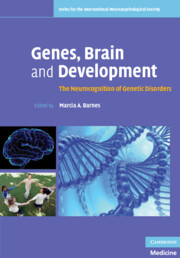Book contents
- Frontmatter
- Contents
- List of Contributors
- Preface
- Acknowledgments
- Section 1 Connecting genes, brain, and behavior in neurodevelopmental disorders
- 1 Intergenerational effects of mutations in the fragile X mental retardation 1 gene. Fragile X: A model of X-linked mental retardation and neurodegeneration
- 2 Autism: Genes, anatomy, and behavioral outcome
- 3 Development in spina bifida: Neurobiological and environmental factors
- Section 2 Genetic disorders and models of neurocognitive development
- Index
- References
2 - Autism: Genes, anatomy, and behavioral outcome
Published online by Cambridge University Press: 04 August 2010
- Frontmatter
- Contents
- List of Contributors
- Preface
- Acknowledgments
- Section 1 Connecting genes, brain, and behavior in neurodevelopmental disorders
- 1 Intergenerational effects of mutations in the fragile X mental retardation 1 gene. Fragile X: A model of X-linked mental retardation and neurodegeneration
- 2 Autism: Genes, anatomy, and behavioral outcome
- 3 Development in spina bifida: Neurobiological and environmental factors
- Section 2 Genetic disorders and models of neurocognitive development
- Index
- References
Summary
Introduction
Autism is a highly heritable disorder with variable physiological, behavioral, and cognitive expression, and a widely variable set of outcomes. In some ways, not enough is known about each of these levels of expression of the disorder; in some ways, however, too much is known – many findings at the genetic, anatomical, and neurochemical levels have been reported, but are often not replicated or are directly opposite to each other (low vs. high chemical levels, increased vs. decreased volume of particular brain structures), and no successful synthesis of findings across or within levels has yet been made. Given this complex and disjointed set of studies, we have not attempted a comprehensive or synthetic review.
We will not address studies on neurochemistry or other physiological factors that have been raised as possibilities in autism, such as inflammatory processes (Vargas et al., 2005), but will focus on genetics, anatomy, and behavioral/cognitive outcome. We will first describe the basic phenomenology and epidemiology of the autistic syndromes. Second, we will review what is known about the genetic basis of autism. Third, we will describe the current state of knowledge about the neuroanatomy of autism. Finally, we will address outcome: what is known about the outcome of affected children; and most intriguingly, if autism has a genetic basis, which seems to affect basic neuroanatomy, how is it possible that some children “recover” from their autism? (Discussion of autism associated with fragile X syndrome can be found in Chapter 1.)
- Type
- Chapter
- Information
- Genes, Brain and DevelopmentThe Neurocognition of Genetic Disorders, pp. 19 - 52Publisher: Cambridge University PressPrint publication year: 2010
References
- 1
- Cited by

